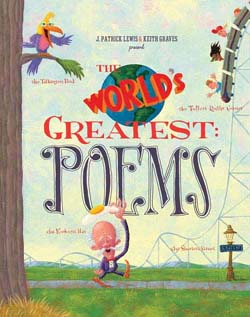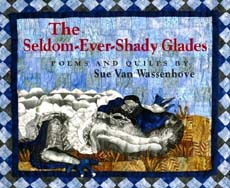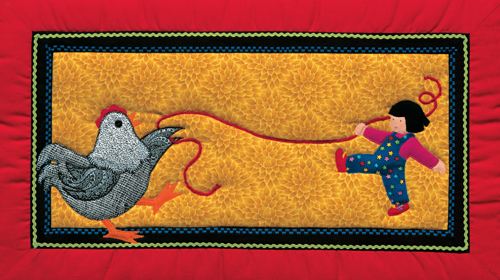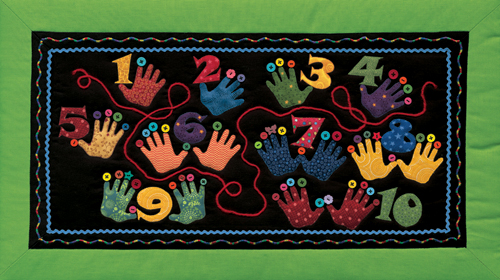National Poetry Month: Big Talk from J. Patrick Lewis and What Happens When Poetry Meets Fabric
 April 3rd, 2008 by jules
April 3rd, 2008 by jules
I promise to talk about books-longer-than-32-pages relatively soon, but today I’m sharing a few more picture book titles in honor of National Poetry Month. Let’s get right to it.

The pebble made rough music,
Humming past a tiny
Island in the Blanco
River.
Touch tone, touch stone.
You could count the beats more or less
Evenly.
It was easy—
Guess
How many times
The pebble dimpled the water.
That is a poem from the latest poetry anthology from the prolific children’s poet, J. Patrick Lewis (and many thanks to him for permission to post it in its entirety here). Entitled The World’s Greatest: Poems (Chronicle Books; January ’08) and illustrated by Keith Graves, it’s the title for that student / child you know who gets inordinately excited over record books, such as Guinness, and who likely has an affinity for hyperbole (and possesses excessive spastic energy, to boot). It’s a lot of fun, this book is. And Graves’ light-hearted illustrations are a fitting match, everything a bit embellished, impossibly preposterous, utterly absurd, and wonderfully hammy.
Lewis takes moments of ultimate extremity and brings them to life in twenty-five short poems. What was the longest traffic jam? Why, that would be one 109.3 miles long in France on February 16, 1980, which Lewis recreates vividly in, arguably, the book’s best poem. The stone-skipping record, as depicted above? Wimberley, Texas, on October 20, 1991. The greatest distance hang gliding by a woman? The longest time a human remained standing? The kookiest hat? The shortest street? You get the idea. Each poem is accompanied by a brief statement of facts — in small print under the title — about the who (if applicable), when, and where of each feat performed (but not the why, mind you, which is good. Lewis leaves it up to the child reader’s imagination to determine just why someone would, say, try to break the cobra-kissing record). Lewis’ poems are expertly-crafted, taking great advantage of The Silly, tripping off one’s tongue with a well-paced meter and boisterious rhymes, and packing as much narrative and action as he can into each stanza. The book is also well-designed overall, including creative titling — such as, the sweeping, arc-like title of “The Longest Time a Message Was in a Bottle at Sea,” all embedded in a huge wave, to the speech-bubble title of “The Talkingest Bird.”
A note on the CIP page indicates that the records are primarily from The Guinness Book of World Records, various editions, and “may have changed since this book was written.” Good point. Someone, indeed, is dotting their i’s and crossing their t’s.
Another winner from Lewis — and an excellent addition to any elementary school library.

 And here are two more titles I recommend, specifically showcasing what happens when “poetry meets fabric.” That link comes from a comment left by author Sara Lewis Holmes over at this post by Kelly Fineman at Writing and Ruminating. That is Kelly’s detailed, very informative review of The Seldom-Ever-Shady Glades: Poems and Quilts (Wordsong, an imprint of Boyds Mills Press; February 2008) — a poetry anthology dedicated to the animals of the Florida Everglades — by poet and illustrator Sue Van Wassenhove. I made the mistake of reading Kelly’s excellent review before sitting down to write mine, and now I just want to send you over to read hers. Indeed. She covered it all. Not to mention that she’s one of the first folks I’d turn to for poetry reviews, as she really knows her stuff, my friends. Here’s an excerpt:
And here are two more titles I recommend, specifically showcasing what happens when “poetry meets fabric.” That link comes from a comment left by author Sara Lewis Holmes over at this post by Kelly Fineman at Writing and Ruminating. That is Kelly’s detailed, very informative review of The Seldom-Ever-Shady Glades: Poems and Quilts (Wordsong, an imprint of Boyds Mills Press; February 2008) — a poetry anthology dedicated to the animals of the Florida Everglades — by poet and illustrator Sue Van Wassenhove. I made the mistake of reading Kelly’s excellent review before sitting down to write mine, and now I just want to send you over to read hers. Indeed. She covered it all. Not to mention that she’s one of the first folks I’d turn to for poetry reviews, as she really knows her stuff, my friends. Here’s an excerpt:
What’s great about this book:
1. The quilts. They are really gorgeous, and work exceedingly well as illustrations. That had to be difficult for Van Wassenhove to manage, because she needed to include images and patterns in order for the quilts to work as quilts, but she also had to leave space for the placement of text. And she managed it magnificently, with excellent fabric, texture and color choices and with enough graphic appeal to hold a reader’s attention.
2. The poems. The poems are as diverse as their subject matter. The rhymed couplets of the first poem give way to a slightly more sophisticated rhyme scheme in the second poem, “Change of Seasons,” which uses a lot of internal rhyme and assonance to move it along. The fourth poem, “Standoff”, is accompanied by a quilt depicting a gape-mouthed gator. The poem itself is a villanelle that uses moderate manipulation in the repeating lines, and succeeds tremendously as a result. “Professor Heron” is a masterpiece of free verse, and is accompanied by a gorgeous appliqué of a great blue heron (which is actually tall and grey) set on a a lush, deep blue patchwork background . . .
This is Wassenhove’s first book for children (which includes some detailed, intricate quilts, as Kelly points out — it boggles the mind to think of how long it must take to create such a book), and I’ll be interested to see what she does next. To see some of the quilts from this title, note that Kelly points this out, part of a January ’08 piece the Miami Herald wrote about this book and Wassenhove’s creations.
And, lest we forget that dear ‘ol Mama Goose is poetry for the wee’est in your life, Anna Grossnickle Hines brings us (via Harcourt; May 2008) 1, 2, Buckly My Shoe, the classic nursery rhyme and counting song, adapted into a picture book with bright patchwork quilted illustrations. Here’s a peek at the final spreads (but sans text):


Hines’ composition is spot-on; her colors, vivid; and the shapes, simple and entirely eye-catching, just right for the toddlers at which the book is aimed. There is a real texture to such illustrations, those made from fabric — and, in this case, quilts — but Hines takes it a step further with her use of buttons and string and intricate stitching. A real delight and a most appealing book for the youngest of readers. Highly recommended.
That’s my story today, and I’m stickin’ to it. Until next time . . .

Jules,
I don’t have this new book by Pat Lewis yet. I’ll have to order a copy. I’ll be posting an interview with him tomorrow for Poetry Friday. That is…I’ll post the interview if I don’t have another computer crisis!
Look at that! I even spelled my name incorrectly in the comment above!
WOO! How exciting, Elaine! I’ll look forward to that.
Oh, those quilts! I want one, especially the big fat hen, who looks like our Fuzzy.
Susan, one of my favorite things about that book are the endpages. They simply feature — from end-to-end — a whole bunch of buttons, of various colors and shapes and sizes. I’m no expert, but sometimes I think it’s good to sit down with wee ones and simply look closely at things, to teach them to observe (which will, ultimately, help them in art — never mind that I have a secret wish for one or both of my girls to enjoy art and continue with it!)…..and spreads like that are so good for that kind of thing. So fun. Just sit and look — “where’s your favorite button?”, “can you find one shaped like a heart?”, “can you find a yellow one?”…..
It really is such a great book for the youngest of children. And esp. a great counting book. Most spreads are the numbers — quilted, of course — and if it’s a “4,” say, there are four buttons. It’s laid out so well — such bright colors. Simple design.
LOVE that hand quilt (I have a thing for hands). Thanks for featuring these!
How great to see that my book is being enjoyed already! I love your thoughts about exploring all those buttons with little ones. The book was great fun to do and I’ve posted a lot of the process on my webpage. Thanks for all the compliments and for helping get the book into the hands of small readers.